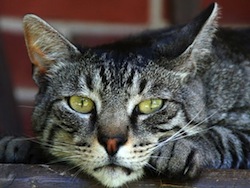By Crystal Connor, DVM
Emergency Veterinarian
Respiratory distress, also referred to as dyspnea (disp-ne´ah), can present in different ways when it comes to our feline friends. The underlying cause can be from various conditions related to either the upper or lower respiratory tract. In some situations, the dyspnea can even be secondary to heart disease or problems outside of the lungs.
Clinical symptoms that may indicate your cat is having difficulty breathing include:
- Coughing
- Open mouth breathing, panting – cats don’t pant like dogs; any signs of open mouth breathing should trigger concern
- Noisy, or high pitch breathing
- Short and shallow breathing pattern
- Breathing with abdominal effort
- Purple or pale gum and or tongue color
- Weakness and collapse
 [2]General causes of dyspnea in cats can include any of the following: severe upper respiratory tract infections, asthma, pneumonia or infection in the lungs, tumors in any part of the respiratory tract that affect airflow, trauma that may result in bleeding into the lungs or chest, and heart failure.
[2]General causes of dyspnea in cats can include any of the following: severe upper respiratory tract infections, asthma, pneumonia or infection in the lungs, tumors in any part of the respiratory tract that affect airflow, trauma that may result in bleeding into the lungs or chest, and heart failure.
When a cat presents to the veterinary hospital for trouble breathing various diagnostic tests will be performed by your veterinarian in order to determine the cause of the dyspena. One of the most important tests will be x-rays of the chest. This will help determine if the disease process is within the lungs our outside of the lungs. Blood work such as a Complete Blood Count (CBC) and Chemistry Panel will also be needed and in some situations advanced testing such as infectious disease screening and an airway wash will be recommended. If it is determined that the dyspnea is secondary to heart failure then blood pressure measurements and an ultrasound of the heart (echocardiogram) will be vital in order to determine severity of the heart disease and what specific medications are needed.
Stabilization therapy will always be needed initially to help your cat breathe easier. This generally involves oxygen therapy and low stress handling. Beyond this, treatment will be based on the underlying medical condition. For example, cats who are experiencing respiratory distress secondary to asthma most often benefit from steroid and bronchodilator therapy, whereas cats who are suffering from congestive heart failure benefit from diuretic therapy (such as Lasix) and cardiac medications.
So what should you do if your cat is having trouble breathing? First and foremost, remain calm. Please know that cats who are in respiratory distress or are having difficulty breathing are often very stressed and panicked. A normal response in such cats can be to bite. It is extremely important to keep this in mind when transporting your cat to the hospital for care. They should be placed into a travel carrier and low stress handling is important. If you do not have a travel carrier a laundry basket with a blanket over the top can be used. Ultimately, the most important thing you can do is to stay calm and get your cat to your veterinarian or local veterinary emergency hospital as soon as possible.
AMVS is a 24-hour veterinary facility providing specialty internal medicine, surgery, emergency and critical care, physical rehabilitation, pain management, and blood bank services for pets. They are located in Longmont at 104 S. Main St. For more information, go to www.AspenMeadowVet.com [1].
